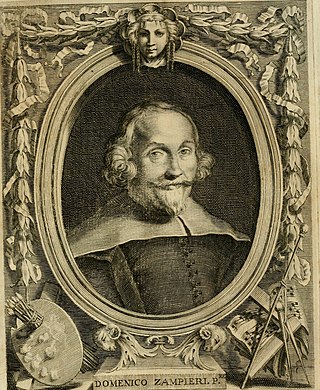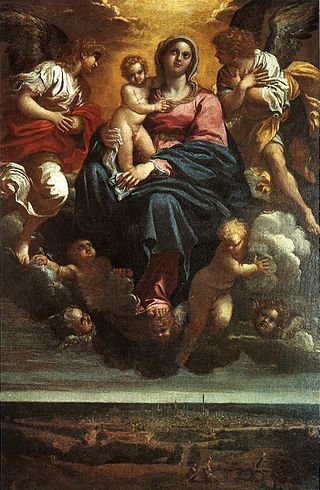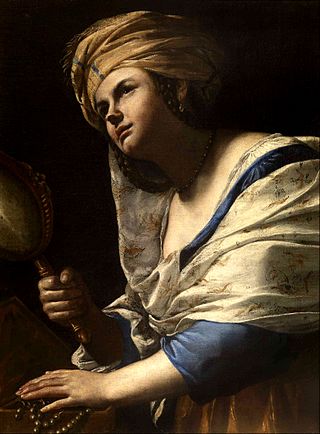Related Research Articles

Agostino Carracci was an Italian painter, printmaker, tapestry designer, and art teacher. He was, together with his brother, Annibale Carracci, and cousin, Ludovico Carracci, one of the founders of the Accademia degli Incamminati in Bologna. Intended to devise alternatives to the Mannerist style favored in the preceding decades, this teaching academy helped propel painters of the School of Bologna to prominence.

Annibale Carracci was an Italian painter and instructor, active in Bologna and later in Rome. Along with his brother and cousin, Annibale was one of the progenitors, if not founders of a leading strand of the Baroque style, borrowing from styles from both north and south of their native city, and aspiring for a return to classical monumentality, but adding a more vital dynamism. Painters working under Annibale at the gallery of the Palazzo Farnese would be highly influential in Roman painting for decades.
The Salimbeni Prize is awarded by the Fondazione Salimbeni per le Arti Figurative of San Severino Marche to honour excellence in the writing of art history on an Italian subject. The Premio Salimbeni was established in 1983.

Domenico Zampieri, known by the diminutive Domenichino after his shortness, was an Italian Baroque painter of the Bolognese School of painters.

Giovanni Battista Salvi da Sassoferrato, also known as Giovanni Battista Salvi, was an Italian Baroque painter, known for his archaizing commitment to Raphael's style. He is often referred to only by the town of his birthplace (Sassoferrato), as was customary in his time, and for example seen with da Vinci and Caravaggio.

Antonio Marziale Carracci was an Italian painter. He was the natural son of Agostino Carracci.

Giovanni Lanfranco was an Italian painter of the Baroque period.

The Loves of the Gods is a monumental fresco cycle, completed by the Bolognese artist Annibale Carracci and his studio, in the Farnese Gallery which is located in the west wing of the Palazzo Farnese, now the French Embassy, in Rome. The frescoes were greatly admired at the time, and were later considered to reflect a significant change in painting style away from sixteenth century Mannerism in anticipation of the development of Baroque and Classicism in Rome during the seventeenth century.

The Cerasi Chapel or Chapel of the Assumption is one of the side chapels in the left transept of the Basilica of Santa Maria del Popolo in Rome. It contains significant paintings by Michelangelo Merisi da Caravaggio and Annibale Carracci, two of the most important masters of Italian Baroque art, dating from 1600 to 1601.

Giovanni Pietro Bellori, also known as Giovan Pietro Bellori or Gian Pietro Bellori, was an Italian art theorist, painter and antiquarian, who is best known for his work Lives of the Artists, considered the seventeenth-century equivalent to Vasari's Vite. His Vite de' Pittori, Scultori et Architetti Moderni, published in 1672, was influential in consolidating and promoting the theoretical case for classical idealism in art. As an art historical biographer, he favoured classicising artists rather than Baroque artists to the extent of omitting some of the key artistic figures of 17th-century art altogether.

Italian Baroque art is a term that is used here to refer to Italian painting and sculpture in the Baroque manner executed over a period that extended from the late sixteenth to the mid eighteenth centuries. Italian Baroque architecture is not covered.

The Carracci were a Bolognese family of artists that played an instrumental role in bringing forth the Baroque style in painting. Brothers Annibale (1560–1609) and Agostino (1557–1602) along with their cousin Ludovico (1555–1619) worked collaboratively. The Carracci family left their legacy in art theory by starting a school for artists in 1582. The school was called the Accademia degli Incamminati, and its main focus was to oppose and challenge Mannerist artistic practices and principles in order to create a renewed art of naturalism and expressive persuasion.

Giovanni Battista Agucchi was an Italian churchman, Papal diplomat and writer on art theory. He was the nephew and brother of cardinals, and might have been one himself if he had lived longer. He served as secretary to the Papal Secretary of State, then the Pope himself, on whose death Agucchi was made a titular bishop and appointed as nuncio to Venice.

The Lives of the Modern Painters, Sculptors, and Architects or Le vite de' pittori, scultori et architetti moderni is a series of artist biographies written by Gian Pietro Bellori (1613–96), whom Julius von Schlosser called "the most important historiographer of art not only of Rome, but all Italy, even of Europe, in the seventeenth century". It is one of the foundational texts of the history and criticism of European art.

Fabio Mochi, aka MOKI, is an Italian designer, illustrator and publisher.

Danaë was a 1600-1605 oil on canvas painting by Annibale Carraci, destroyed during World War II. An autograph preparatory study survives in the Royal Collection at Windsor Castle.

Christ and the Canaanite Woman is a 1594-1595 oil on canvas painting by Annibale Carracci, now in the Pinacoteca Stuard in Parma.

Madonna and Child in Glory over the City of Bologna is a c.1593 oil on canvas painting by Annibale Carracci, also known as The Virgin and Child in the Clouds or the Madonna of Bologna. It is now in Christ Church Picture Gallery in Oxford.

The Last Communion of Saint Jerome or The Communion of Saint Jerome is an oil on canvas painting by Italian painter Agostino Carracci, created c. 1592-1597. It was produced for San Girolamo alla Certosa church in Bologna and it is now held in the Pinacoteca Nazionale di Bologna.

Vanitas is an oil-on-canvas painting executed ca. 1650–1670 by the Italian artist Mattia Preti, now inventory number 9283 in the Uffizi in Florence, for which it was bought in 1951 from a private collection. Art historians diasgree on whether the painting is a fragment of a larger work or retains its original dimensions, as well as whether it is a general vanitas or depicts Mary Magdalene.
References
- ↑ "Evelina Borea". einaudi.it. Giulio Einaudi editore. Retrieved 13 January 2023.
- ↑ Terzaghi, Maria Cristina (December 2011). "Evelina Borea". No. 315. Il Giornale dell'Arte. Retrieved 25 July 2014.
- ↑ Borea, Evelina (1970). Caravaggio e Caravaggeschi nelle gallerie di Firenze. Florence: Mostra Firenze, Sansoni. Retrieved 25 July 2014.
- ↑ Colantuono, Anthony (September 2001). "L'idea del bello: Viaggio per Roma nel Seicento con Giovanni Pietro Bellori by Evelina Borea; Carlo Gasparri; Luciana Arcangeli; Lucilla de Lachenal". The Burlington Magazine. 143 (1182): 576–577. JSTOR 889276.
- ↑ Spear, Richard (December 1967). "Review: Domenichino by Evelina Borea". The Art Bulletin. 49 (4): 360–368. doi:10.2307/3048499. JSTOR 3048499.